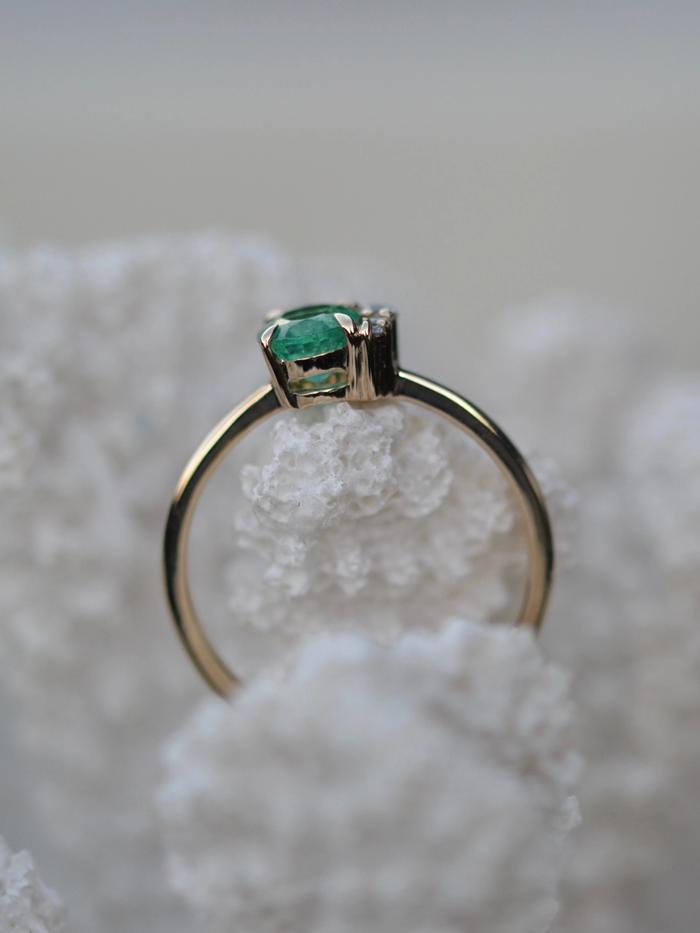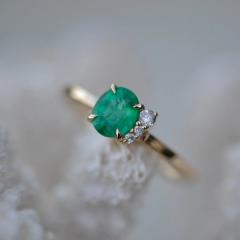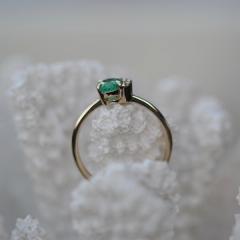Language and currency settings
Change your language and currency settings by selecting your preferences below
Select currency
Select language





Emerald & Diamonds
While this one-of-a-kind piece is sold, we are able to create a unique version just for you within your desired price range. Please use our Ring Designer to start the process.
Details
DETAILS
- A 0,68 carat natural, green emerald set in 14K solid yellow gold surrounded by three round brilliant lab-grown diamonds in G/Top Wesselton color and VS1 clarity totaling 0,04 carat
Warranty
Every piece is hand made with love, and we are so sure about the quality of our products that we offer a lifetime warranty should there be any manufacturing fault.
For more information on the Nangi warranty, please visit our Terms & Conditions page
Return
In-stock sizes, as well as size 54, are eligible for return within 90 days of receipt. Other sizes are made-to-order just for you and cannot be refunded. For more information on Nangi returns, please visit our Terms & Conditions page
Lab-grown diamonds
Sustainability is our foundation. That is why Nangi is proud to be the first and only Norwegian jeweler to offer Lab-Grown Diamonds. Atomically identical to mined diamonds, our laboratory-grown diamonds are created in a lab, utilizing solely renewable energy, meaning that the origin of our diamonds is certain. Lab-grown diamonds offer the exact same clarity and quality as mined ones. The only difference is that they are created in a more sustainable and eco-friendly way.
Emerald
Emerald is the bluish green to green variety of beryl, a mineral species that includes aquamarine. Emerald’s lush green has soothed souls and excited imaginations since antiquity. Its name comes from the ancient Greek word for green, “smaragdus.”
Emeralds are the rarest gemstones and are typically mined in Colombia, Brazil, Afghanistan and Zambia. The first known Emerald mines were in Egypt, dating from at least 330 BC into the 1700's.
The gemstone has many special qualities, but colored stone professionals generally agree that emeralds are, most of all, about color. Emerald has been the standard for green among colored stones for thousands of years.
Emeralds typically contain inclusions that are visible to the unaided eye. Because of this, trade members and some consumers understand and accept the presence of inclusions in emeralds.
It’s important to understand that inclusions are a natural part of emeralds, and you should always expect to find them. Inclusions in emeralds are special, and if an emerald doesn't have any inclusions it is most likely synthetic, or an imitation. Emerald inclusions are often described as looking mossy or garden-like. They’re sometimes called “jardin,” which is French for garden. In the rare case of eye-clean emeralds, they are especially valuable.
Emerald scores an 8 on Mohs Hardness Scale.
This unique gemstone is the birthstone of May and is considered to be a symbol of rebirth and love. It symbolizes hope, growth, renewal and the search for meaning.
Cleopatra was known to have a passion for emerald, and used it in her royal adornments. Legends endowed the wearer with the ability to foresee the future when emerald was placed under the tongue, as well as to reveal truth and be protected against evil spells. Emerald was once also believed to cure diseases like cholera and malaria. Wearing an emerald was believed to reveal the truth or falseness of a lover’s oath as well as make one an eloquent speaker.
Legend also states that emerald was one of the four precious stones given by God to King Solomon. These four stones were said to have endowed the king with power over all creation.
RING SIZE GUIDE
Find Your Perfect Ring Size
Click here to see our size guide
| Diameter (mm) | EU | US & Canada | UK / Australia | Switzerland | Singapore / Japan |
| 14.1 | 44 | 3 | F 1/2 | 4 | 4 |
| 14.3 | 45 | G | 5 1/4 | 5 | |
| 14.5 | 3.5 | G 1/2 | |||
| 14.7 | 46 | H | 6 1/2 | 6 | |
| 14.9 | 47 | 4 | H 1/2 | 7 | |
| 15.1 | I | 7 3/4 | |||
| 15.3 | 48 | 4.5 | I 1/2 | 8 | |
| 15.5 | J | 9 | |||
| 15.7 | 49 | 5 | J 1/2 | 9 | |
| 15.9 | 50 | K | 10 | ||
| 16.1 | 5.5 | K 1/2 | 10 | ||
| 16.3 | 51 | L | 11 3/4 | ||
| 16.5 | 52 | 6 | L 1/2 | 12 3/4 | 11 |
| 16.7 | M | 12 | |||
| 16.9 | 53 | 6.5 | M 1/2 | 14 | 13 |
| 17.1 | N | ||||
| 17.3 | 54 | 7 | N 1/2 | 15 1/4 | 14 |
| 17.5 | 55 | O | |||
| 17.7 | 7.5 | O 1/2 | 16 1/2 | 15 | |
| 17.9 | 56 | P | |||
| 18.1 | 57 | 8 | P 1/2 | 17 3/4 | 16 |
| 18.2 | |||||
| 18.3 | Q | ||||
| 18.5 | 58 | 8.5 | Q 1/2 | 17 | |
| 18.8 | 59 | R | 19 | ||
| 19.0 | 9 | R 1/2 | 18 | ||
| 19.2 | 60 | S | 20 1/4 | ||
| 19.4 | 61 | 9.5 | S 1/2 | 19 | |
| 19.6 | T | 21 1/2 | |||
| 19.8 | 62 | 10 | T 1/2 | 20 | |
| 20.0 | U | 21 | |||
| 20.2 | 63 | 10.5 | U 1/2 | 22 3/4 | 22 |
| 20.4 | 64 | V | |||
| 20.6 | 11 | V 1/2 | 23 | ||
| 20.8 | 65 | W | 25 | ||
| 21.0 | 66 | 11.5 | W 1/2 | 24 | |
| 21.2 | X | ||||
| 21.4 | 67 | 12 | X 1/2 | 27 1/2 | 25 |
| 21.6 | Y | ||||
| 21.8 | 68 | 12.5 | Z | 28 3/4 | 26 |
| 22.0 | 69 | Z 1/2 | |||
| 22.2 | 70 | 13 | 27 | ||
| 22.4 | Z+1 |
Join the Nangi family!
Subscribe to our newsletter to be the first to know when we release new one-of-a-kind pieces, and gain exclusive access to secret sales and events
Norsk side
Nangi Fine Jewelry © 2024

